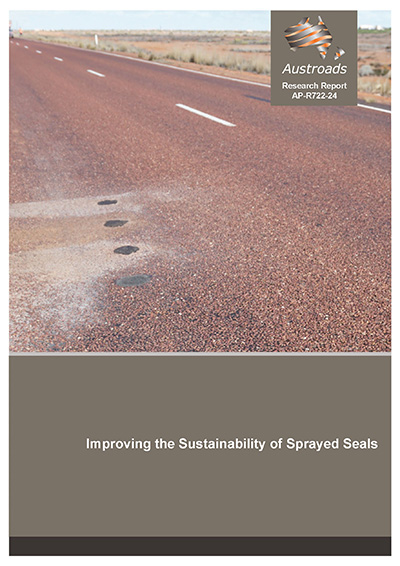Pavement

- Publication no: AP-R722-24
- ISBN: 978-1-922994-56-1
- Published: 19 December 2024
- PDF (free) Download
This report explores sprayed seal technologies and practices to improve their sustainability and reduce their environmental impact.
Sprayed seals are a widely used, critical component of the road system in Australia and New Zealand, serving as the predominant type of sealed road surfacing in both countries. Traditional sprayed sealing practices rely heavily on non-renewable, virgin materials for their two main components – the bituminous binders refined from crude oil and aggregates extracted from quarries.
The purpose of this report is to gather knowledge and increase the understandings about sprayed seal technologies and practices that can be used to improve their sustainability in terms of environmental impact. This report contains a literature review, conducted to identify and evaluate new and emerging environmentally friendly, sustainable technologies and practices and innovative materials and methods for sprayed seals.
This report describes current sprayed seal materials and practice and explores alternative approaches to binders (including additives, emulsions and bio-binders), aggregates and precoating, cutter oils, and construction equipment. The report also discusses lifespans of sprayed seals, impacts of climate change and an environmental life cycle analysis to review the impact of different sealing approaches.
Watch a recording of the webinar to learn more.
- Summary
- 1. Introduction
- 1.1 Purpose and Objective
- 1.2 Scope
- 2. Sprayed Seals Overview
- 2.1 Types of Sprayed Seals
- 2.2 Materials
- 2.3 Construction Practices and Equipment
- 2.4 Traffic
- 2.5 Defects/Deterioration
- 3. Current Practice with Binders and Cutters
- 3.1 Australia
- 3.2 New Zealand
- 3.3 South Africa
- 3.4 United States
- 3.5 Europe
- 3.6 Comparisons of Sustainable Practices
- 4. Alternatives to Existing Materials and Practice
- 4.1 Reducing Cutter Usage
- 4.2 Bitumen Emulsions
- 4.3 Warm Mix Asphalt Technologies
- 4.4 Re-refined Engine Oil Bottoms
- 4.5 Foamed Bitumen
- 4.6 Synchronised Sprayers and Aggregate Spreaders
- 4.7 Forward Moving Aggregate Spreaders
- 4.8 Alternative Materials
- 4.9 Variable Sprayers
- 4.10 Retexturing Surfaces
- 4.11 Discussion
- 5. Bio-materials
- 5.1 Background
- 5.2 Biomass
- 5.3 Production Methods for Bio-oils and Bio-binders
- 5.4 Characterisation of Bio-oils
- 5.5 Characterisation of Bio-binders for Road Applications
- 5.6 Polymer Modified Bio-binders
- 5.7 Other Applications
- 5.8 Ageing Behaviour of Bio-binders
- 5.9 Commercial Products
- 5.10 Industry Consultation
- 5.11 Discussion
- 6. Environmental Impact and Climate Change Effects on Sprayed Seals
- 6.1 Environmental Impact
- 6.2 Climate Change
- 6.3 Discussion
- 7. Extending Life
- 7.1 Expected Lifespans
- 7.2 Effect of Hardening
- 7.3 Austroads Seal Life Prediction Model
- 7.4 Delaying Binder Hardening
- 7.5 Discussion
- 8. Life Cycle Assessment
- 8.1 Introduction
- 8.2 Inputs and Assumptions
- 8.3 Life Cycle Assessment Results
- 8.4 Discussion
- 9. Conclusions
- References
